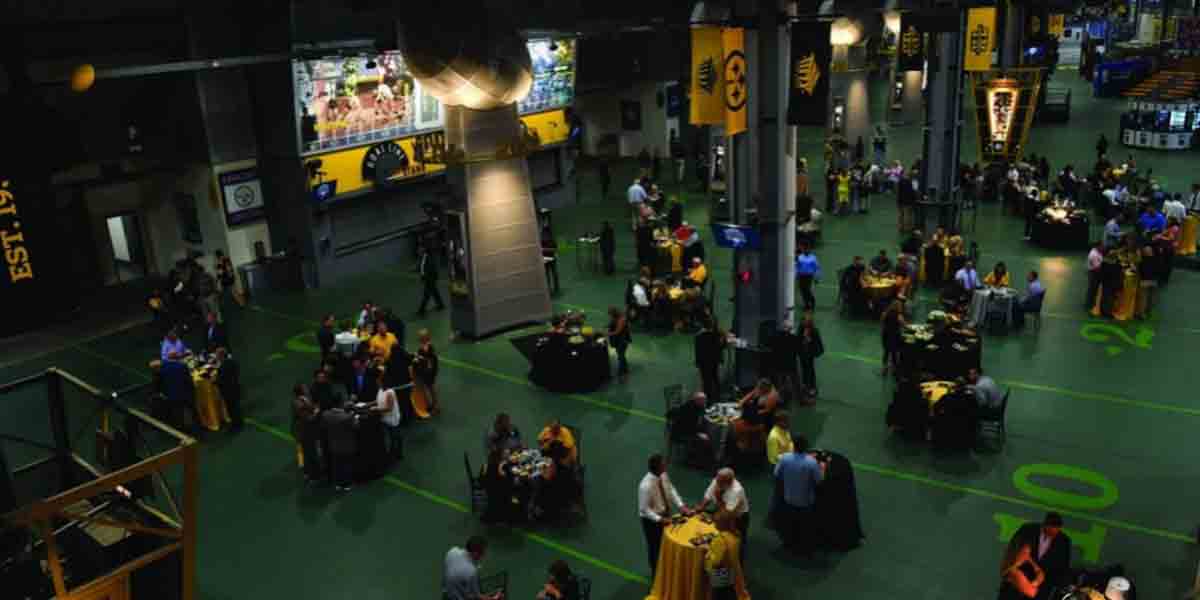The Transformation of the North Shore & Acrisure Stadium
The North Shore – where Acrisure Stadium and PNC Park, along with several office, entertainment, retail and dining developments, currently stand – has been the site of Pittsburgh’s professional and college sports dynasty since the late 19th century. The area has grown and changed as much as the stadiums and the teams it houses, serving as the foundation of Pittsburgh’s storied professional and college sports history throughout.
The North Shore’s transformation from a service yard to an integral part of downtown Pittsburgh – and the evolution of both the facilities and the Steelers, the Pirates and the Pittsburgh Panthers themselves – demonstrate the extent to which the Pittsburgh community and its professional and college sports teams have worked together through public-private partnerships to achieve better outcomes for the entire city. Pittsburgh sports fans, neighbors and tourists alike can enjoy their favorite teams, shows, museums and more just steps from downtown Pittsburgh, and the North Shore itself is now a bustling extension of the urban core.
Below is a brief history of Acrisure Stadium and its predecessors – and how Pittsburgh grew into the regional sports and entertainment hub it is today.
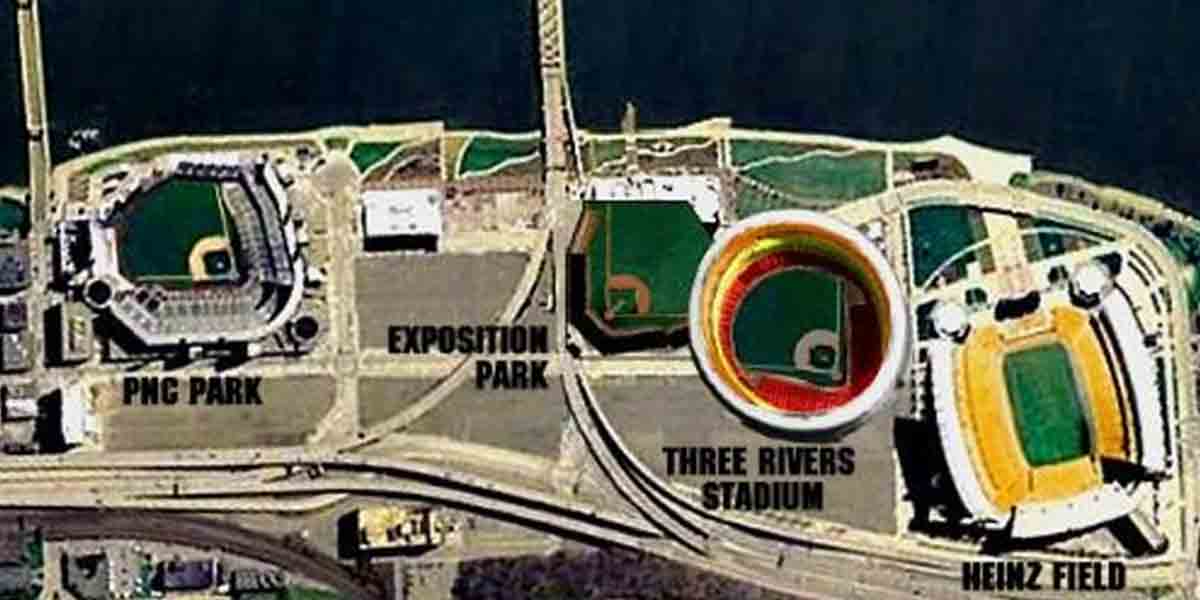
Forbes Field & Birth of the Pittsburgh Steelers: 1909-1963
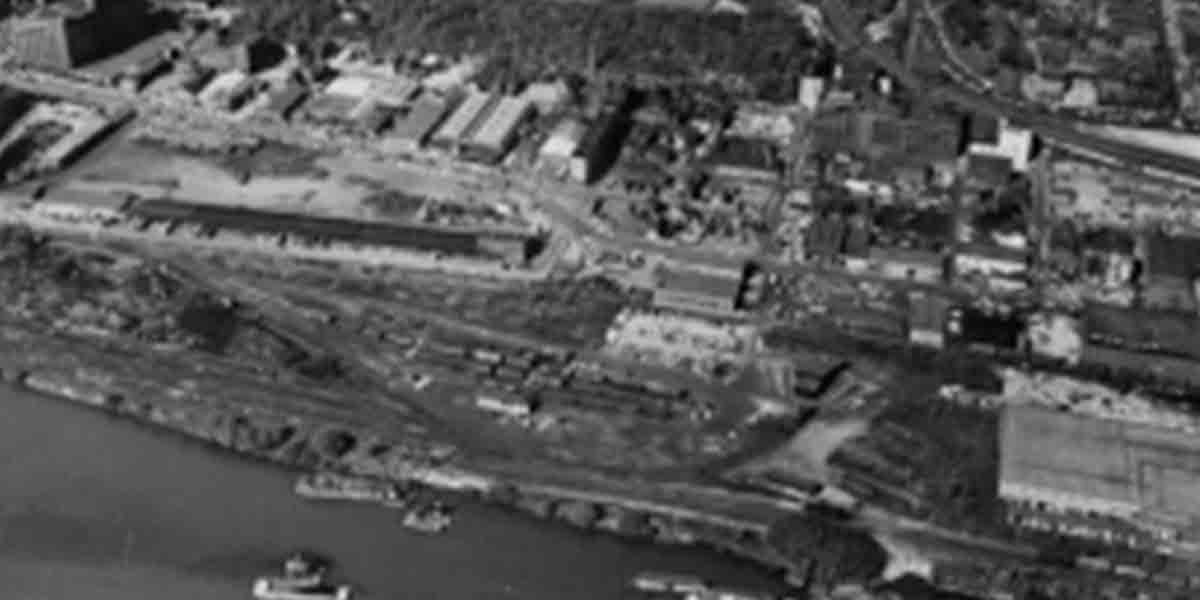
Long before it was inhabited by several Lombardi and World Series trophies, Pittsburgh’s North Shore was a junk and service yard, housing industrial overloads from the city.
While the North Shore powered Pittsburgh’s industrial economy, neighboring Forbes Field opened on June 30, 1909, and played host to the Pirates (1909-1970) and the Pitt Panthers (1909-1924). When the Pittsburgh Steelers were founded by Arthur J. Rooney on July 8, 1933, the team called Forbes Field its home stadium. Starting in 1958, the Steelers split home games between Forbes Field and Pitt Stadium until 1964, when they started playing at Pitt Stadium exclusively.

Three Rivers Stadium Hosts the Steelers and the Pirates in a Golden Era: 1970-2000
Construction on a new, larger home for the Steelers and Pirates began in 1968, when Huber, Hunt & Nichols and Mascaro Construction broke ground on Three Rivers Stadium under the design guidance of Deeter, Ritchey, Sipple Associates and Michael Baker Jr.

The $55 million ($439 million when adjusted for modern inflation) project was funded by a public and private split and was completed in 29 months, with both the Steelers and the Pirates playing their first games at Three Rivers Stadium in 1970. The stadium’s seated capacity was nearly 48,000 for baseball games and 59,000 for football games.
Three Rivers Stadium was home to the Steelers for more than 30 years – an era that included four Super Bowl wins (1974, 1975, 1978 and 1979), an additional conference championship in 1995, and 14 AFC Central titles (1972, 1974, 1975, 1976, 1977, 1978, 1979, 1983, 1984, 1992, 1994, 1995, 1996 and 1997). The legendary era featured iconic coaches in Chuck Noll and Bill Cowher, leading standout players Terry Bradshaw, Franco Harris, John Stallworth, Rod Woodson, Mike Webster, and countless others who etched their way into Pittsburgh and football lore. The Pirates also called the stadium home for parts of 30 years, opening the stadium in earnest with a World Series triumph in 1971 before winning again in 1979.
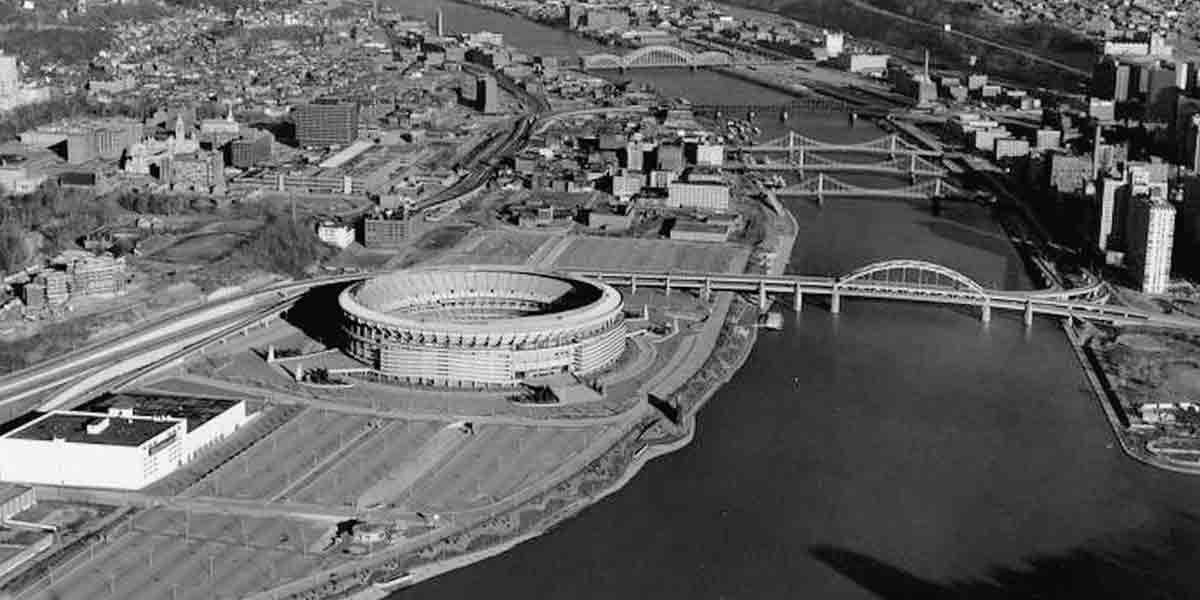

A State-of-the-Art Football Stadium for a New Millennium: 2001-Present
Given the Steelers’ significant success and immense popularity, the franchise outgrew its home of three decades. Seeking to welcome more fans, draw top entertainment from around the world, keep pace with other major U.S. cities and stay current with the latest stadium trends – including expanded fan amenities – Steelers leadership, in concert with the University of Pittsburgh, began to lobby for a new state-of-the-art football stadium in the late 1990s.
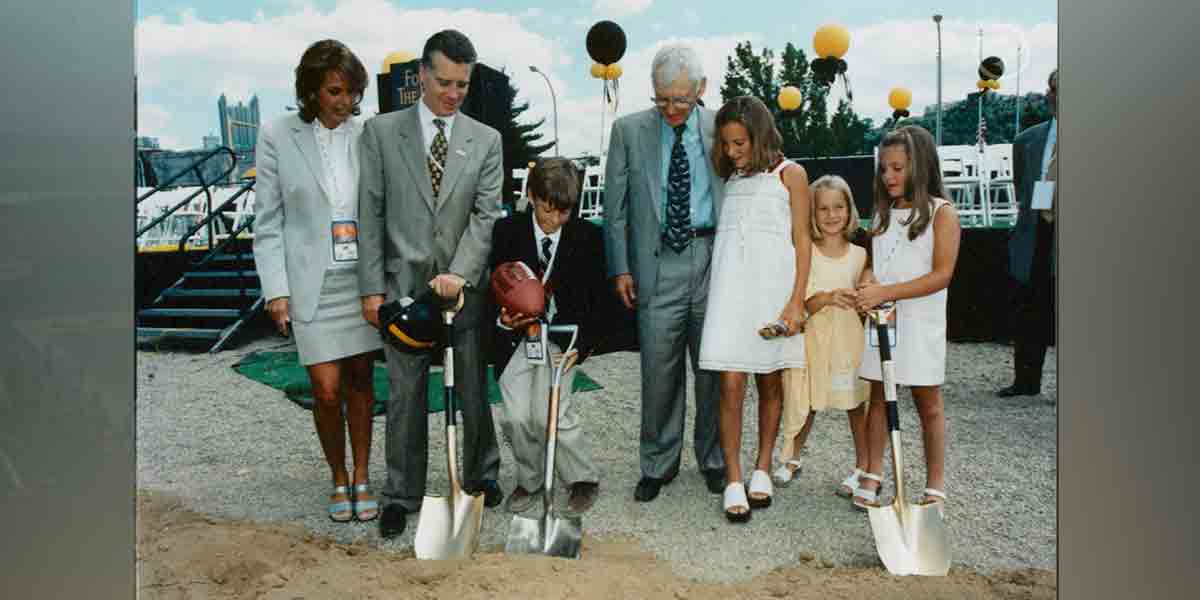
The construction of Heinz Field (now known as Acrisure Stadium) was made possible with funds from the Allegheny Regional Asset District (RAD) and a tax paid on hotel/motel rooms, accrued mostly from out-of-town tourists. A multi-team, multi-site deal that also included the construction of the Pirates’ PNC Park and an expansion of the David L. Lawrence Convention Center, public funds across the three projects totaled $809 million[KM1] , with $233 million allocated for the football stadium in addition to $76.5 million in private funding from the Steelers. Under the agreement, the Sports & Exhibition Authority of Pittsburgh and Allegheny County would hold ownership of the stadiums.


NSYNC was the last band to perform at Three Rivers Stadium on July 16, 2000, and played the first show at the new Heinz Field on Aug. 18, 2001.
Heinz Field was completed in 2001, in just over two years. Home to both the Steelers and the Pittsburgh Panthers, the new stadium was constructed by Hunt Construction Group and Mascaro Construction Company, LP, under the guidance of architects HOK Sport. The new stadium seated 68,400, which included 7,300 club seats and 129 luxury suites.

In 2012, the Steelers partnered with FedEx to develop the FedEx Great Hall, which includes the “Walk of Fame,” the Steelers Hall of Fame, six interactive display columns featuring Steelers and Panthers memorabilia, murals, and a studio.
In 2014, Heinz Field underwent its first renovation, which included an additional scoreboard and access to free WiFi within the FedEx Great Hall and West Concourse. Expanded concession and entertainment options included the Bud Light Deck, which fits up to 150 guests who have access to a private bar and food service with great views.
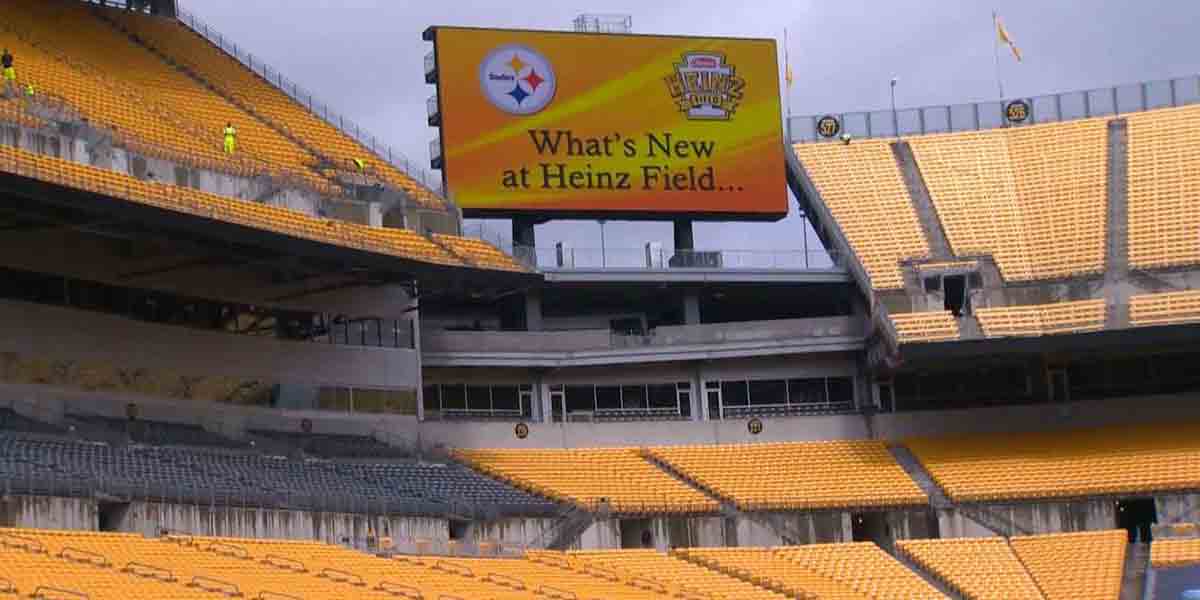
The following year saw Heinz Field’s South End Expansion, with the addition of a 3,000-seat South Plaza, three new concession stands, the 30,000 square foot PNC Champions Club with five new private suites, the Ford Fan Zone with three specialty food stands, and the Chiefs Room cigar bar in honor of Art Rooney Sr.


3,000 additional seats were added to Heinz Field via the South End Expansion.
More recent additions to Heinz Field and Acrisure Stadium include a $2.5 million renovation of Pub 33 to build access from both inside and outside the stadium in 2018. In 2019, the Steelers built a two-story addition to the FedEx Great Hall to make room for a new merchandise shop along Art Rooney Avenue.

Acrisure Stadium has 64 food and beverage stands managed by Aramark, including 20 grab-and-go “Walk Thru Brus.”
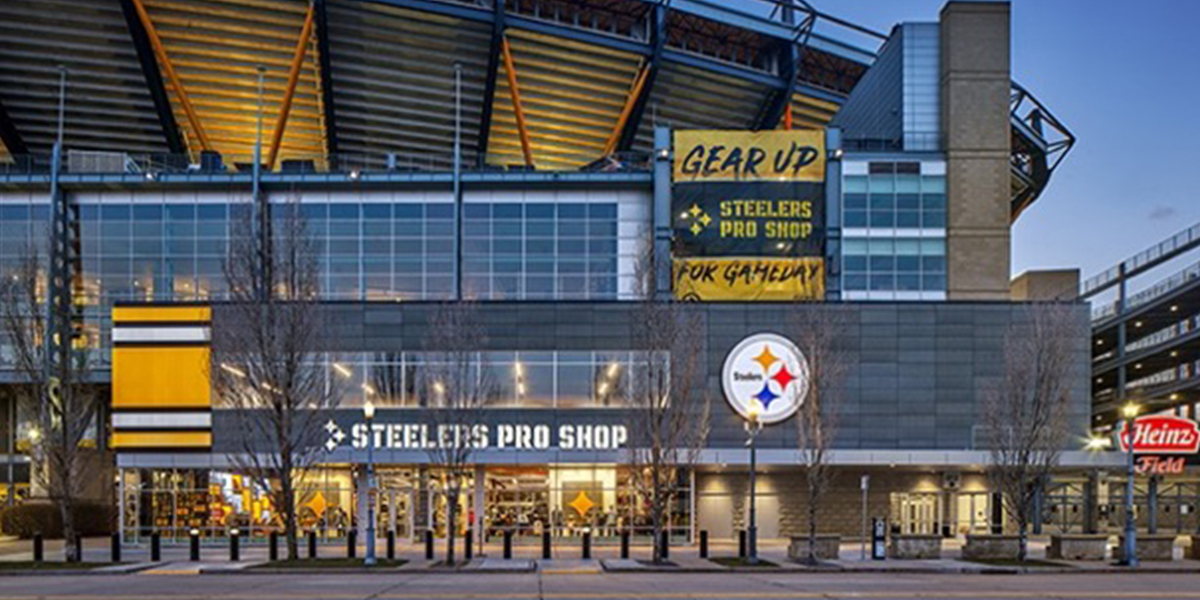
In 2022, Acrisure took over naming rights of the stadium after an era of more than two decades and two Super Bowl wins with Heinz Field as the named home of the Steelers. The partnership between the Steelers and Acrisure has enabled the franchise to continue to invest in stadium amenities and aesthetics, including new stadium signage for the 2022 season. The partnership has also included community initiatives aimed at providing a deep connection for Acrisure in the Pittsburgh community and brand recognition both locally and nationally to support Acrisure's growth.
"Acrisure provided us with an opportunity to ensure our stadium continues to be a valuable asset for our fans as well as keeping up with the market value of NFL stadiums,” Steelers President Art Rooney II said at the time.

The Steelers Hall of Honor Museum marks the first addition to the newly-named Acrisure Stadium complex. Among its attractions, the fan-friendly museum follows a chronological flow of Steelers history focusing on the key moments and people that made the history happen, with life-sized player mannequins, one-of-a-kind artifacts, exclusive game-worn uniform pieces, replicated offices of founder Art Rooney Sr. and Daniel M. Rooney, the Steelers’ six Super Bowl rings, and touch-screen informational kiosks that include bios, photos, and videos on the Hall of Honor inductees and the storied Steelers history.
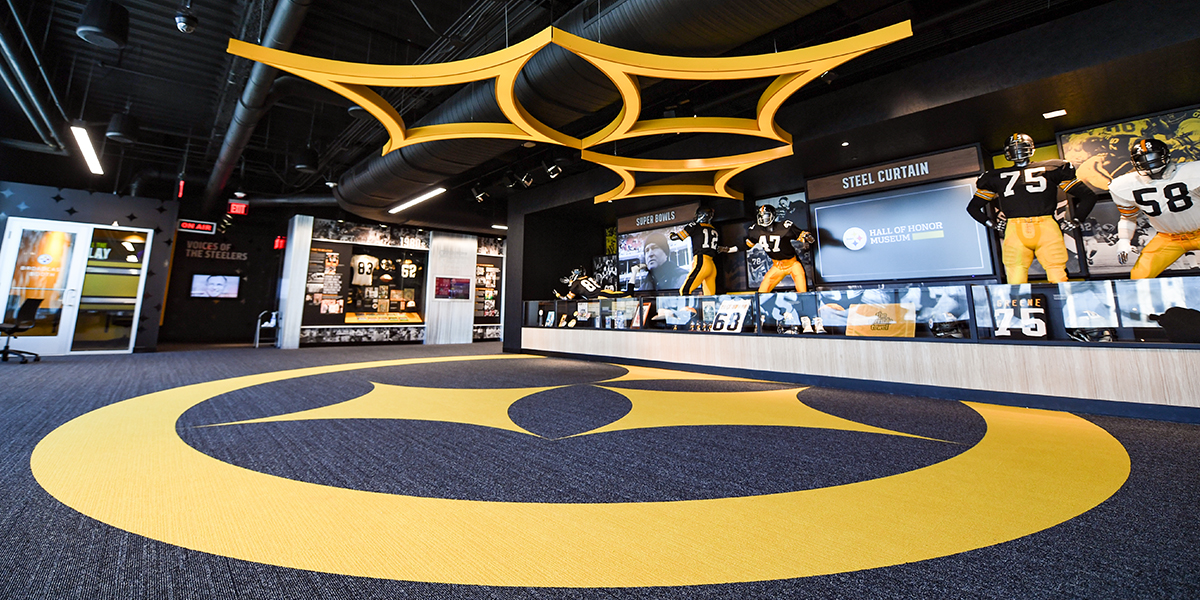
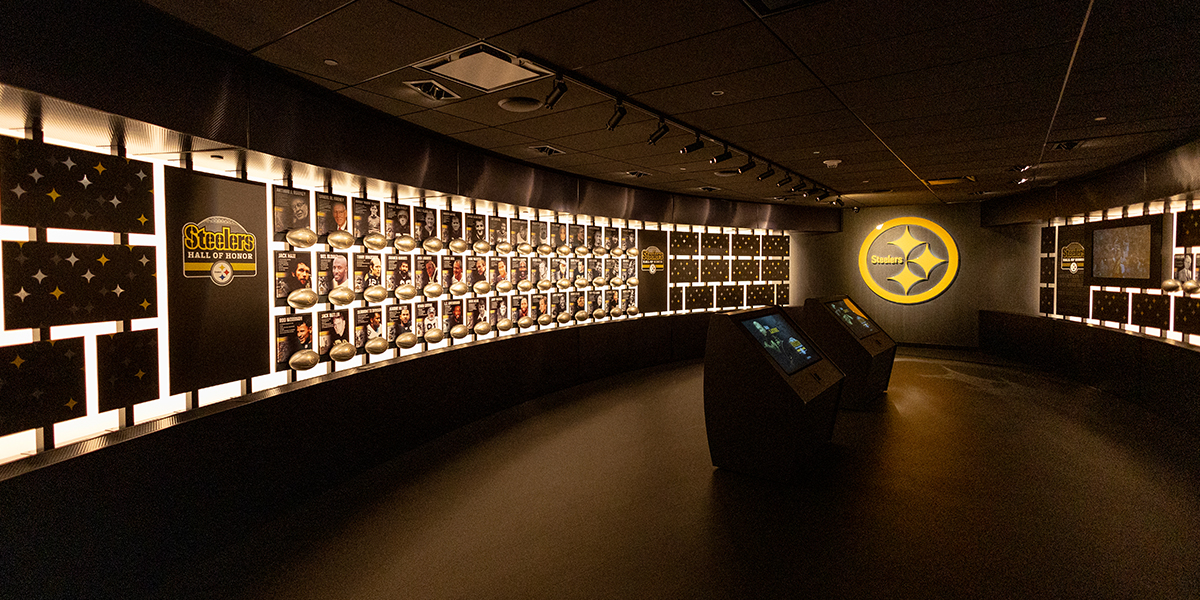
Additional highlights from recent years include a two-night performance by Taylor Swift during her world-renowned Eras Tour, which saw a record-breaking attendance number of 73,117 fans on the second night and generated $46 million in direct spending in the City of Pittsburgh, including $42.9 in spending from out-of-town fans, according to VisitPITTSBURGH.

Steelers offer include 400 Standing Room Only tickets for the Steelers and another 100 through the new Student Rush program.
North Shore Development Alongside Heinz Field & Acrisure Stadium Growth
Following the successful build of new stadiums, both the Steelers and the Pirates set their sights on developing the North Shore area directly surrounding the stadiums to further incorporate their home fields into the Pittsburgh community. In 2003, the Stadium Authority, the City of Pittsburgh, and North Shore Developers, L.P., entered into an agreement under which the Steelers and the Pirates were able to drive commercial development to the North Shore. The area under the agreement includes the land between PNC Park and what is now Acrisure Stadium, as outlined below:
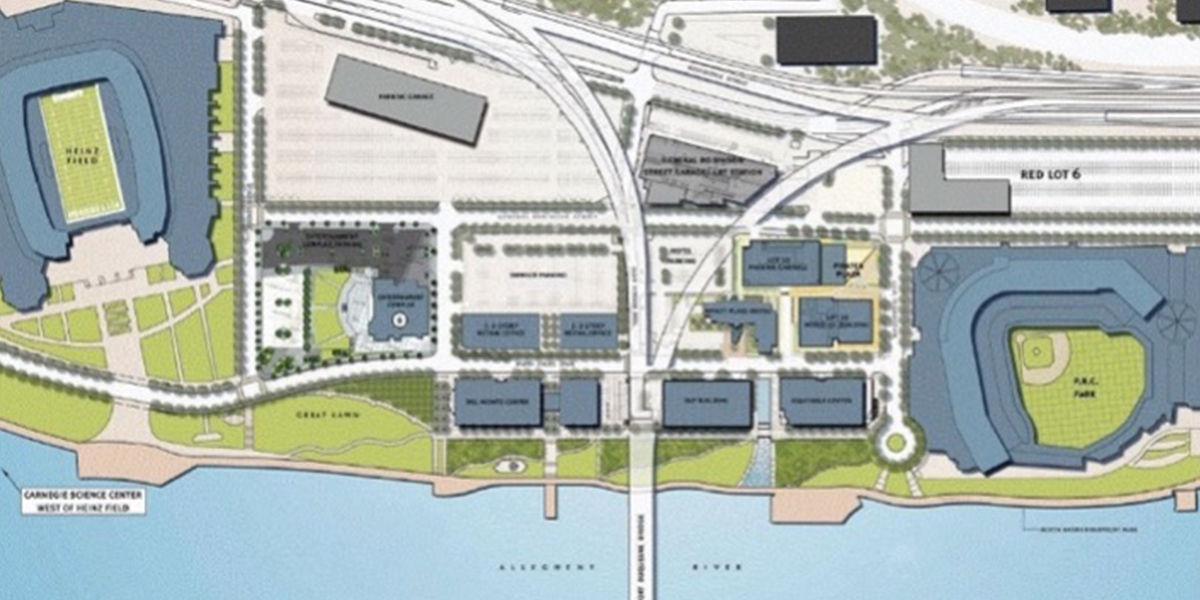
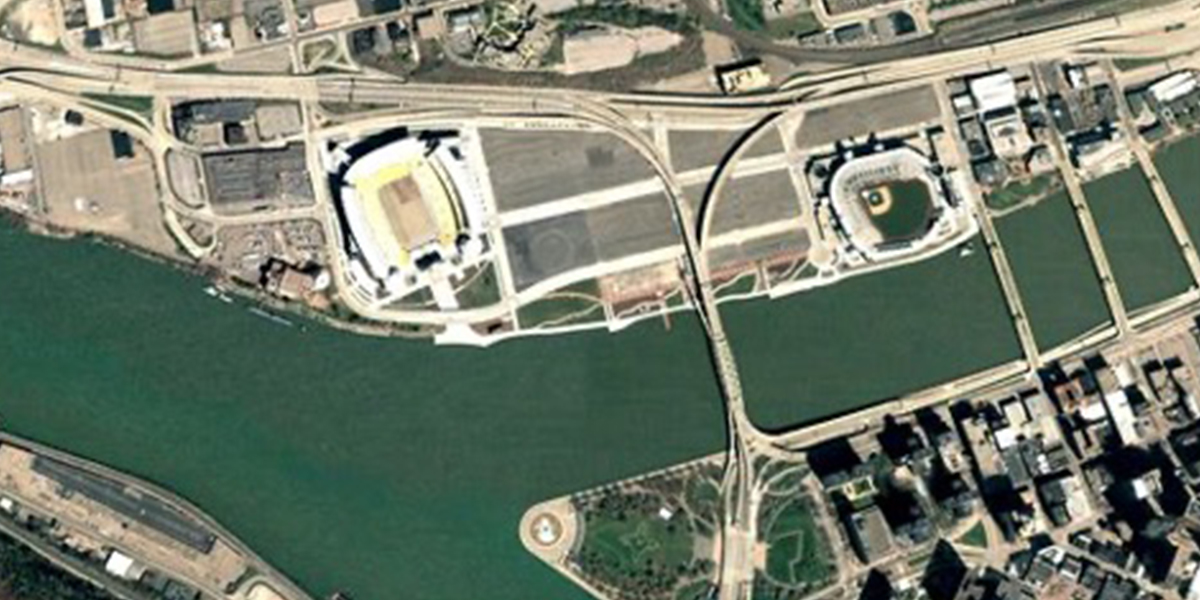
Between 2003 and 2004, the Stadium Authority approved the Steelers’ and Pirates’ proposal for the development of two nearby parcels, which included the construction of restaurant and retail space on the ground level and office space above it. The project was completed by 2006 and resulted in 831,000 square feet of new office space; over 250,000 square feet in retail, restaurant, and hotel space; over 36,000 square feet of entertainment space; and over 900,000 square feet in parking spots (not including surface lots).
In 2015, independent architecture and design firm Sasaki Associates measured that the $130 million invested in the 13-mile Three Rivers Park has helped to produce nearly $4.1 billion in development on and near the riverfront since 2001, with property values along the stretch jumping by 60 percent compared to 32 percent in the rest of the city.
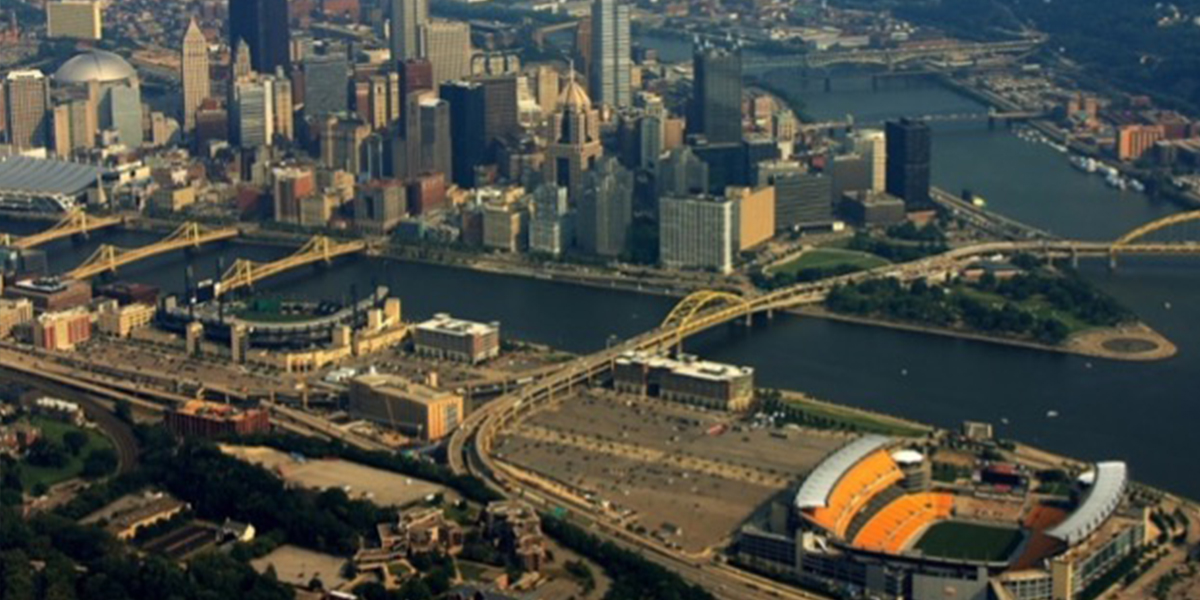
To provide the Pittsburgh community with a greater variety of live entertainment options, the Steelers, alongside Continental Real Estate Companies, in 2010 invested $13 million to build Stage AE on a four-acre parcel that was previously a surface parking lot adjacent to Heinz Field. The venue presents more than 200 indoor and outdoor concerts and events year-round and can seat up to 5,000. Construction also introduced developments such as Hyatt Place Hotel, the People’s Gas Building, North Shore Place I and II, which include five retail spaces and two floors of office space, and the light rail T Station.
With so many new restaurants, entertainment offerings, and office spaces, the North Shore quickly became an integral extension of downtown Pittsburgh. In order to keep up with demand and make the North Shore’s offerings accessible to all, a proposal to build the North Shore Connector light-rail extension under the Ohio River was approved and received more than $300 million in federal funding in 2004. Construction was completed in 2012, with regular service launching to two new stations, North Side Station and Allegheny Station, that spring.

Thousands of fans take the train to Acrisure Stadium for home games.
Concurrently, the region saw the development of the 16th Street Bridge (known as the David McCullough bridge) and the casino along the North Shore, helping cement Pittsburgh’s iconic downtown scene. Today, the North Shore boasts 192 acres of usable land in total, including 11.25 acres of public and green space.
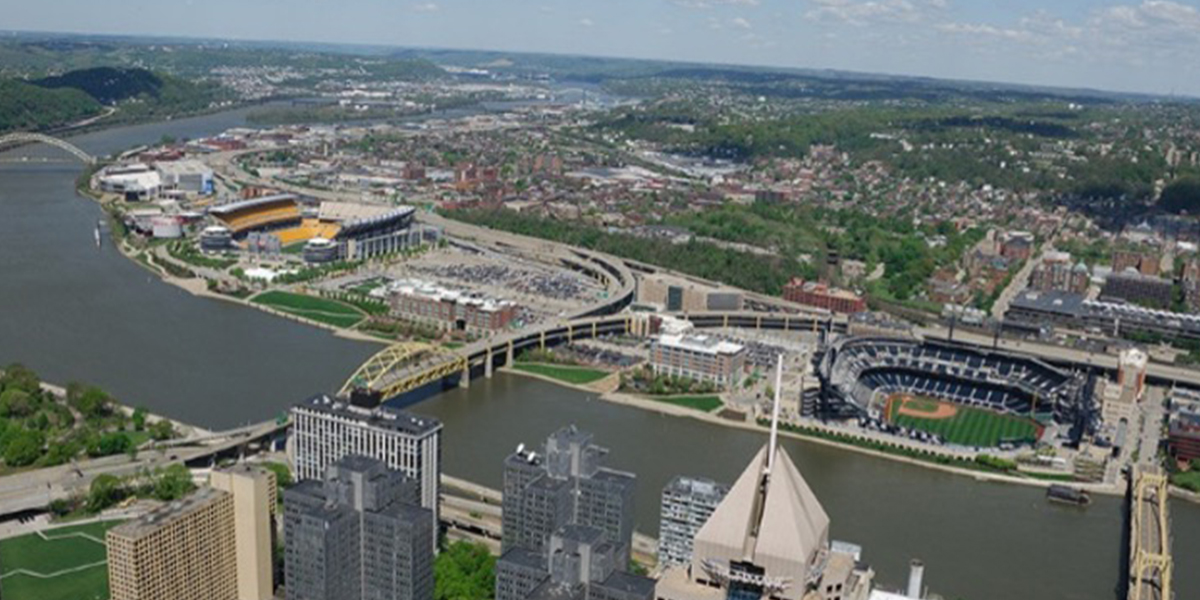
As the land and surface parking lots surrounding the stadium continued to expand entertainment, dining, and business offerings for the Pittsburgh community, additional parking solutions were needed. In 2016, Massaro Construction started construction on the Gold 1 Garage. The six-story, 998-parking facility was completed in 2017 and is managed by ALCO Parking Corporation. There were approximately 607 net new spaces in the lot , as well as free electrical charging stations available to charge electric and electric-hybrid vehicles and 100 bike spaces.
![North_Shore_Gold_1_Garage Gold 1 Garage [center].](https://acrisurestadium.com/wp-content/uploads/2023/12/North_Shore_Gold_1_Garage.jpg)
LOOK AHEAD: 2024 AND BEYOND
The Pittsburgh Steelers continue to bring millions of fans to the North Shore for football games, special events, and concerts, which helps to boost the Pittsburgh economy. From a service yard to Three Rivers Stadium and now Acrisure Stadium, the North Shore has seen many improvements over the years. The investments the Steelers made and continue to make in the development of the North Shore ensure the City and fans' experience around the stadium is enjoyable and help foster lifelong memories for generations to come. The Pittsburgh Steelers and Rooney family is a legacy unlike any other teams in the NFL; they will continue that legacy and hold high standards on and off the field.
- Upcoming Events - Click Here >>>
- Keep updated with Latest Steeler News - Click Here >>>

